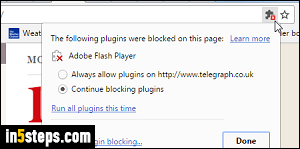

- #ALLOW PLUGINS CHROME PDF#
- #ALLOW PLUGINS CHROME INSTALL#
- #ALLOW PLUGINS CHROME SOFTWARE#
- #ALLOW PLUGINS CHROME PLUS#
- #ALLOW PLUGINS CHROME WINDOWS#
#ALLOW PLUGINS CHROME INSTALL#
Obviously the list of add-ons will evolve with what the user will install in the future.To use the ID card with Google Chrome, it is necessary to allow the use of the Token Signing plugin. It is a browser that is ready for Web applications with plugins as it is in its design. The particularity of Chrome is the integration of Gears by default and ActiveX (which is also part of Internet Explorer). Comparison with SafariĪlthough it shares technologies with Chrome, Safari does not support the command, but you get the list from the options.


The Microsoft's browser does not recognize the command.īut you can have the list from the browser: Silverlight is part of the list in recent versions of Opera.
#ALLOW PLUGINS CHROME PLUS#
There are also the same plugins without ActiveX, Gears, plus Java. The differences are the ActiveX and Gears plugins which are not present in Firefox. They are almost the same modules, even if some could have been added to the browser. The same command in Firefox could displays the following list, according to what you have installed: These gadgets are displayed on a Web page thanks to the plugin, or on the desktop. One option in the Under the hood tab in the options panel allows you to specify how each site can use Google Gears. The Google Gears plugin allows Web applications to work offline. The version 1.0 of Silverlight, more portable, does not have widgets but has graphics functions and supports XAML. The Microsoft framework to facilitate the creation of online applications. Then, you need to turn off the button for the extension you want to turn it off. You can see the extensions list in Chrome. NET, which manages the processing of XAML. Click the three-dot menu on the top-right corner of the web browser.
#ALLOW PLUGINS CHROME WINDOWS#
Windows Presentation FoundationĪ graphical interface system in. Googles Chrome version 45 and above have dropped support for NPAPI, and therefore Java Plugin do not work on these browsers anymore.
#ALLOW PLUGINS CHROME PDF#
Used to display PDF files with the browser. The Java Plugin for web browsers relies on the cross-platform plugin architecture NPAPI, which had been supported by all major web browsers for over a decade. Native ClientĪllow to run in the brower applications in native code, so faster. Disable this plugin if you do not use this app. Work with the the Remote Desktop application (which control remotely your computer). Runtime from Adobe to display Flash pages or games. Note that in practice both modes are used simultaneously for compatibility with all browsers. Only Internet Explorer passes the first test. These tests show that with Chrome qu'ActiveX does not create an XHR object, only the standard format is recognized. In this test, it is only an XMLHttpRequest object compliant with the W3C standard that is created. In this test the XMLHttpRequest object is created only in the form of ActiveX object. To check how the XMLHttprequest object works with Chrome, two test pages were put online: The most common is XMLHttpRequest which is the basis of Ajax but it is an ActiveX object in Internet Explorer and a browser object otherwise. Used to recognize ActiveX objects from Microsoft. We can see by comparing with other browsers that Google offers two more modules: ActiveX and Google Gears and it does not include Java by default. Opera began supporting extensions in 2009, and both Google Chrome and. Browsers typically allow a variety of extensions, including user.
#ALLOW PLUGINS CHROME SOFTWARE#
When you type this command in the address bar, the browser displays the list of modules added to the browser, which are most often available in the form of additional plugins. A browser extension is a small software module for customizing a web browser. Description of the command about: plugins in the Chrome browser and comparison of the list of add-ons of other browsers.


 0 kommentar(er)
0 kommentar(er)
